- By Dan Veaner
- Around Town
 Print
Print
The little white barn behind the Lansing Community Center is the historical records building for the Town of Lansing. This unassuming building houses hundreds of years of Lansing history, has a special humidity-controlled room for delicate documents, and includs the office of Louise Bement, Lansing's official town historian. "I'm a very creative, very busy town historian," she says. "I do a lot that other town historians don't do."
That's for sure! Aside from growing and maintaining the town's collection of historical documents and artifacts, Bement maintains the historic Field School, a one room schoolhouse that was moved to its present location next to the records building from its original home on Peruville Road. People bring her things for the town's collection. She does an enormous amount of research, helps people who are researching their family histories, is president of the board of trustees of the Lansing Historical Association , and somewhere along the way has found time to write numerous articles and two books about Lansing, plus collaborate on another seven.
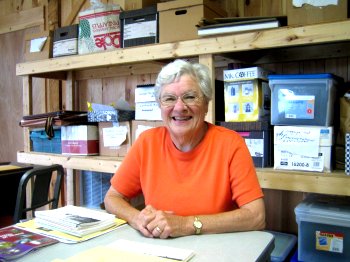
Lansing Town Historian Louise Bement
Bement grew up in Pennsylvania. After graduating from Mansfield Teacher's College where she trained to teach middle and high school history, she taught in Bath in 1954 and 1955. That's when she married husband Bill. The couple moved to Lansing in 1969. "I went to (then Lansing school superintendent) Mr. Buckley and said I would like to teach seventh or eighth grade or high school social studies," she recalls. "He looked at my resume. I had taken all these reading courses as graduate work at Elmira College. He said, 'You're going to teach fourth grade because you had all these reading courses.' I thought, 'How do you teach fourth grade?!' I think the reason I was a good fourth grade teacher is that I didn't know how to do it!"
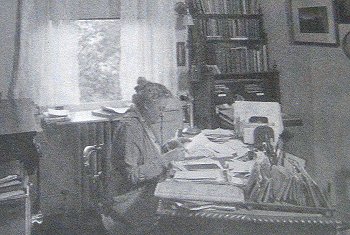
Alice Bristol, the first town historian
She soon figured it out. Bement wrote four books about the history of the town with her fourth graders. Three chronicled the history of the salt mines, and the fourth told the history of Cayuga Lake. The students conducted interviews and wrote letters to get first hand source material for the books.
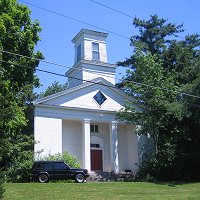
The Asbury Methodist Church
is now a home
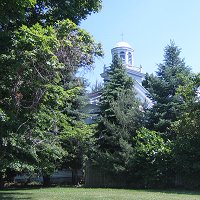
The East Lansing Baptist Church
is also a home today
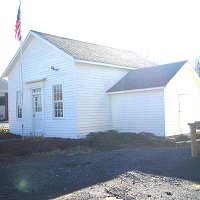
The Field one room school
house is open to the
public a few times per year
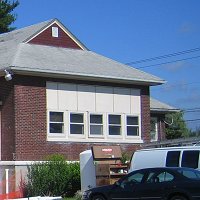
The Lansing library originated
as a schoolhouse
In addition to the four books Bement wrote with her students, she authored 'Ludlowville Memory Book, and 'Town of Lansing, It's Beginning.' She has collaborated with various different authors, which she continues to do to this day. Bement teamed with Genoa Town Historian Gordon Cummings to write 'The History of the Town of Milton' chronicles the former town that was made up of what is not Lansing and Genoa before they were split when Tompkins County was formed. She worked with the county historical society to coauthor 'The Towns of Tompkins County.' In 2004 she was one of 16 local historians who contributed to 'Place Names of Tompkins County, edited by County Historian Carol Kammen. That book provides little mini-histories of more than two dozen Lansing locations.
In that she is following in the footsteps of previous Lansing historians, whom she credits for passing down a rich, well organized collection. The first known Lansing historian was Alice Bristol, who wrote 'The History of Ludlowville,' about 100 pages of memories of the village in its heyday. Bristol was a child in Ludlowville in the 1860s. She became engaged to Will Barr, who then broke the engagement. With the money she got for breach of promise she went to Washington, D.C. to open a girl's finishing school.
Bristol came back to Lansing right after the crash in 1929. She closed her school, was reportedly the last to get her money out before the banks folded, and came home to live in the family's Ridge Road house with her sister Kate and two brothers. She became secretary of the Pine Grove Cemetery Association. Brother Walter would drive his sisters to church in Ludlowville each Sunday in a surrey with a fringe on top. Later Bristol was seen driving her car on Lansing's roads collecting material for her manuscript in her electric Brougham.
Next came Susan Howell Haring, who probably worked with Bristol before becoming historian herself. Isabel Wood Parrish then worked with Haring. Parrish was a school teacher in Ludlowville, and Bement notes that she was not well liked by the students. But she chronicaled Lansing history and her book 'It Happened In lansing' is still for sale by the Lansing Historical Association.
Haring and Parrish worked from the 1940s to the 1960s until Parrish died in 1964. A few others worked at Lansing's history sporadically until Candy Ferris became town historian. Ferris's mother Ruby wrote memories of Lansing, one of which was included in the most recent Lansing Historical Association newsletter.
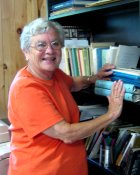 Bement became town historian in 1981, and now Janette Reeves is beginning to work with her in preparation for the eventual handing over of the reigns. "I do the whole nine yards," Bement says. "I've always felt that a stranger to a town, as I was in 1959, is more apt to delve in and learn about the whole town, because I had no prejudices when I came here. I didn't think that Ludlowville was the be-all and end-all when I came here, and I didn't think that Myers was, and I didn't think that South Lansing was different from North Lansing, although it is extremely different! But I was more open to everything."
Bement became town historian in 1981, and now Janette Reeves is beginning to work with her in preparation for the eventual handing over of the reigns. "I do the whole nine yards," Bement says. "I've always felt that a stranger to a town, as I was in 1959, is more apt to delve in and learn about the whole town, because I had no prejudices when I came here. I didn't think that Ludlowville was the be-all and end-all when I came here, and I didn't think that Myers was, and I didn't think that South Lansing was different from North Lansing, although it is extremely different! But I was more open to everything."
She receives frequent phone calls, emails, and unexpected visits from people doing genealogy. "One of the most fun things I did last summer was when the Conrads came from California," she recalls. "Doctor Conrad had been a pediatrician, and he was in his 80s. His cousin was in his early 70s, and the baby of the group was in his early 60s. I spent five hours with them because I have such wonderful records. I found where every single one of their relatives were buried in Lansing. We found every single grave and they took pictures of them. We went to the old Dutch cemetery, Asbury Cemetery, and North Lansing Cemetery."
Sometimes she is asked to research history for the town. "Now and then there will be a question," she says. "Interesting things, too. Often I'm asked by people doing deed searches for archaeological information -- are there any Indian graves here or things like that. When they were investigating building the Watchtower Society building at Kingdom Farm (the project was never realized) I helped them on archaeology and history."
She can't always help everyone, especially when she is asked for things that have nothing to do with the town. "It's a joy to be town historian, but you do meet some crazies!" she says. "They call you on the phone and if you can't tell them the answer they don't want to give up."
New York State law requires all cities, towns, and villages to have an official historian. Bement sees it as a compliment to the work she does that she has been on the town payroll since 1987 as well as the town constructing record building, which was just completed. Prior to that she somehow managed to keep track of everything spread around town, in her house, and a rental storage unit. Through all of that she continues to love being Lansing's historian. "It's so interesting," she says. "You meet a lot of wonderful people. I'm a born historian so I love to do research. I love prime sources, that's my favorite thing. It's just fun."
----
v4i26
That's for sure! Aside from growing and maintaining the town's collection of historical documents and artifacts, Bement maintains the historic Field School, a one room schoolhouse that was moved to its present location next to the records building from its original home on Peruville Road. People bring her things for the town's collection. She does an enormous amount of research, helps people who are researching their family histories, is president of the board of trustees of the Lansing Historical Association , and somewhere along the way has found time to write numerous articles and two books about Lansing, plus collaborate on another seven.

Lansing Town Historian Louise Bement
Bement grew up in Pennsylvania. After graduating from Mansfield Teacher's College where she trained to teach middle and high school history, she taught in Bath in 1954 and 1955. That's when she married husband Bill. The couple moved to Lansing in 1969. "I went to (then Lansing school superintendent) Mr. Buckley and said I would like to teach seventh or eighth grade or high school social studies," she recalls. "He looked at my resume. I had taken all these reading courses as graduate work at Elmira College. He said, 'You're going to teach fourth grade because you had all these reading courses.' I thought, 'How do you teach fourth grade?!' I think the reason I was a good fourth grade teacher is that I didn't know how to do it!"

Alice Bristol, the first town historian
She soon figured it out. Bement wrote four books about the history of the town with her fourth graders. Three chronicled the history of the salt mines, and the fourth told the history of Cayuga Lake. The students conducted interviews and wrote letters to get first hand source material for the books.
| Lansing's Architectural Heritage It is inevitable that historical buildings disappear, and that is also true in Lansing. In 2005 the nearly 200 year old Beardsley Building, a North Lansing grange hall, was demolished (click here for story). Under private ownership it had been condemned. "The foundation was bad and it was structurally collapsing," says Building Inspector Lynn Day. "The Town did have unsafe building laws. It was right there on the corner. There was a house next to it that actually had a collapsed floor. We were directed to send letters. I believe (former Lansing code enforcement officer) George Totman posted it in the early '90s, so that had been going on for at least a dozen years." Bement says that she has pictures of at least some of these buildings. And she says just driving around town can tell you a lot about its history. "It's really fun if you know your history of architects," she says. "In the 1820s we start here with federal houses, with a roofline parallel to the road, usually with three to five bays. So you can say, 'This place was settled in 1820 because there are all these federal houses. About 1840 the Greek revival came in with the big pillars, and they are perpendicular to the road. Then you get your 1860s Italianates, and second empire, and Eastwood and Victorian Queen Anne. As you go along the road you can date when places were settled if you know your architecture. That is fun." Lansing has 30 cemeteries that can tell you a lot about the history of the town. Some of the names found there are also found on street signs and other place names in the town. While the Rogues Harbor Inn is the most prominent of Lansing's historical buildings, many others dot the town. 'The brick block' is now an apartment building in Ludlowville once housed stores and a post office. A Ludlowville church still stands next door. At one time Lansing had 23 school houses, and some are still standing, most converted for other uses. There is one on East Lansing Road, another on Searles Road, and the North Lansing School is still standing, as well as the Lansing Library, which began as a school, then served as the town hall before being converted to a library. Some historical churches are now homes, including the East Lansing Church and the original Asbury Church. Others are still used including the St. George's Greek Orthodox Church on Syrian Hill, which holds services only a few times per year. | ||

The Asbury Methodist Church
is now a home

The East Lansing Baptist Church
is also a home today

The Field one room school
house is open to the
public a few times per year

The Lansing library originated
as a schoolhouse
In that she is following in the footsteps of previous Lansing historians, whom she credits for passing down a rich, well organized collection. The first known Lansing historian was Alice Bristol, who wrote 'The History of Ludlowville,' about 100 pages of memories of the village in its heyday. Bristol was a child in Ludlowville in the 1860s. She became engaged to Will Barr, who then broke the engagement. With the money she got for breach of promise she went to Washington, D.C. to open a girl's finishing school.
Bristol came back to Lansing right after the crash in 1929. She closed her school, was reportedly the last to get her money out before the banks folded, and came home to live in the family's Ridge Road house with her sister Kate and two brothers. She became secretary of the Pine Grove Cemetery Association. Brother Walter would drive his sisters to church in Ludlowville each Sunday in a surrey with a fringe on top. Later Bristol was seen driving her car on Lansing's roads collecting material for her manuscript in her electric Brougham.
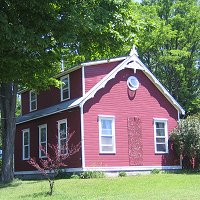 | 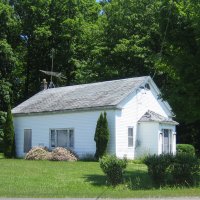 |
| These school houses have been converted to homes | |
Next came Susan Howell Haring, who probably worked with Bristol before becoming historian herself. Isabel Wood Parrish then worked with Haring. Parrish was a school teacher in Ludlowville, and Bement notes that she was not well liked by the students. But she chronicaled Lansing history and her book 'It Happened In lansing' is still for sale by the Lansing Historical Association.
Haring and Parrish worked from the 1940s to the 1960s until Parrish died in 1964. A few others worked at Lansing's history sporadically until Candy Ferris became town historian. Ferris's mother Ruby wrote memories of Lansing, one of which was included in the most recent Lansing Historical Association newsletter.
 Bement became town historian in 1981, and now Janette Reeves is beginning to work with her in preparation for the eventual handing over of the reigns. "I do the whole nine yards," Bement says. "I've always felt that a stranger to a town, as I was in 1959, is more apt to delve in and learn about the whole town, because I had no prejudices when I came here. I didn't think that Ludlowville was the be-all and end-all when I came here, and I didn't think that Myers was, and I didn't think that South Lansing was different from North Lansing, although it is extremely different! But I was more open to everything."
Bement became town historian in 1981, and now Janette Reeves is beginning to work with her in preparation for the eventual handing over of the reigns. "I do the whole nine yards," Bement says. "I've always felt that a stranger to a town, as I was in 1959, is more apt to delve in and learn about the whole town, because I had no prejudices when I came here. I didn't think that Ludlowville was the be-all and end-all when I came here, and I didn't think that Myers was, and I didn't think that South Lansing was different from North Lansing, although it is extremely different! But I was more open to everything."She receives frequent phone calls, emails, and unexpected visits from people doing genealogy. "One of the most fun things I did last summer was when the Conrads came from California," she recalls. "Doctor Conrad had been a pediatrician, and he was in his 80s. His cousin was in his early 70s, and the baby of the group was in his early 60s. I spent five hours with them because I have such wonderful records. I found where every single one of their relatives were buried in Lansing. We found every single grave and they took pictures of them. We went to the old Dutch cemetery, Asbury Cemetery, and North Lansing Cemetery."
Sometimes she is asked to research history for the town. "Now and then there will be a question," she says. "Interesting things, too. Often I'm asked by people doing deed searches for archaeological information -- are there any Indian graves here or things like that. When they were investigating building the Watchtower Society building at Kingdom Farm (the project was never realized) I helped them on archaeology and history."
She can't always help everyone, especially when she is asked for things that have nothing to do with the town. "It's a joy to be town historian, but you do meet some crazies!" she says. "They call you on the phone and if you can't tell them the answer they don't want to give up."
New York State law requires all cities, towns, and villages to have an official historian. Bement sees it as a compliment to the work she does that she has been on the town payroll since 1987 as well as the town constructing record building, which was just completed. Prior to that she somehow managed to keep track of everything spread around town, in her house, and a rental storage unit. Through all of that she continues to love being Lansing's historian. "It's so interesting," she says. "You meet a lot of wonderful people. I'm a born historian so I love to do research. I love prime sources, that's my favorite thing. It's just fun."
----
v4i26



